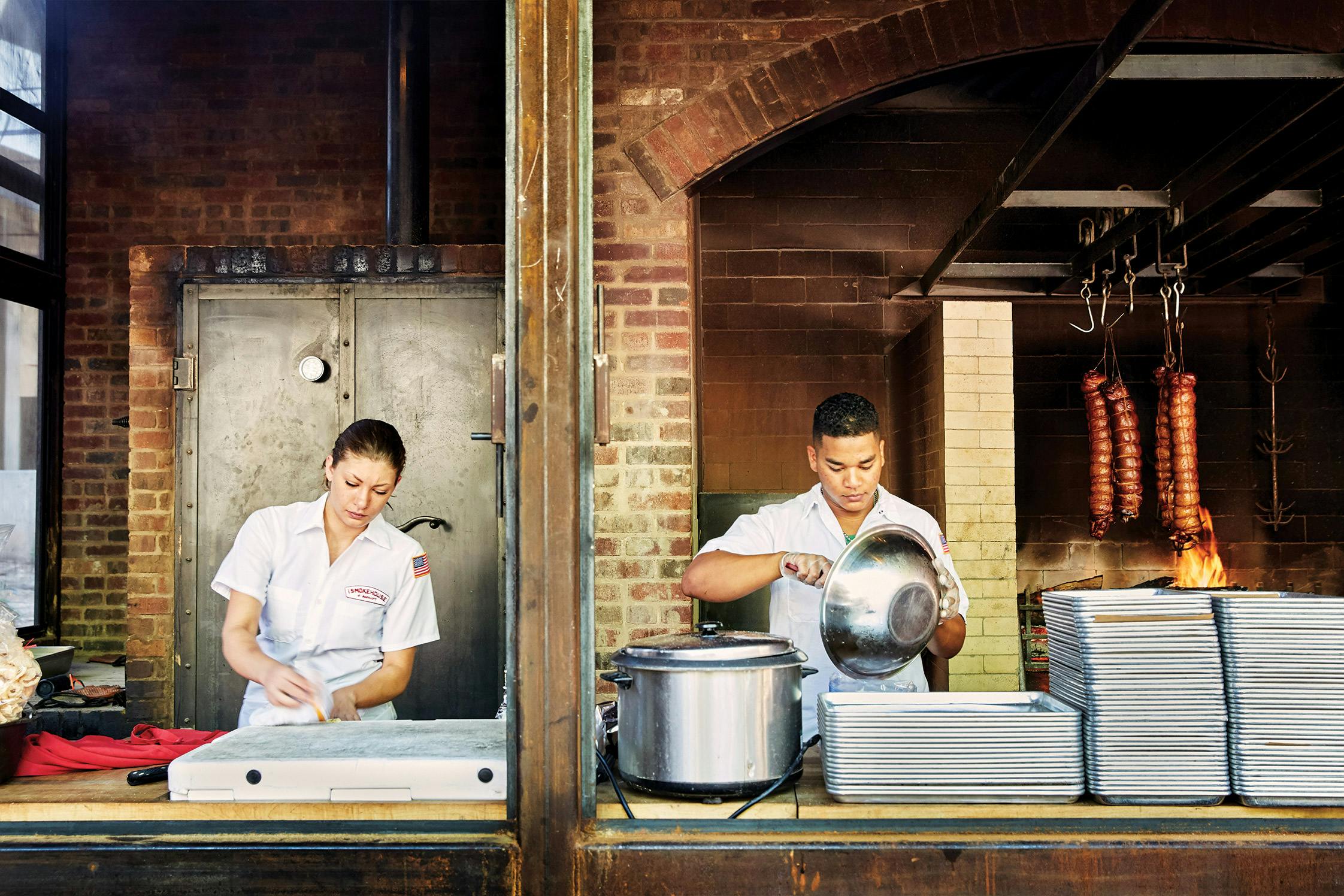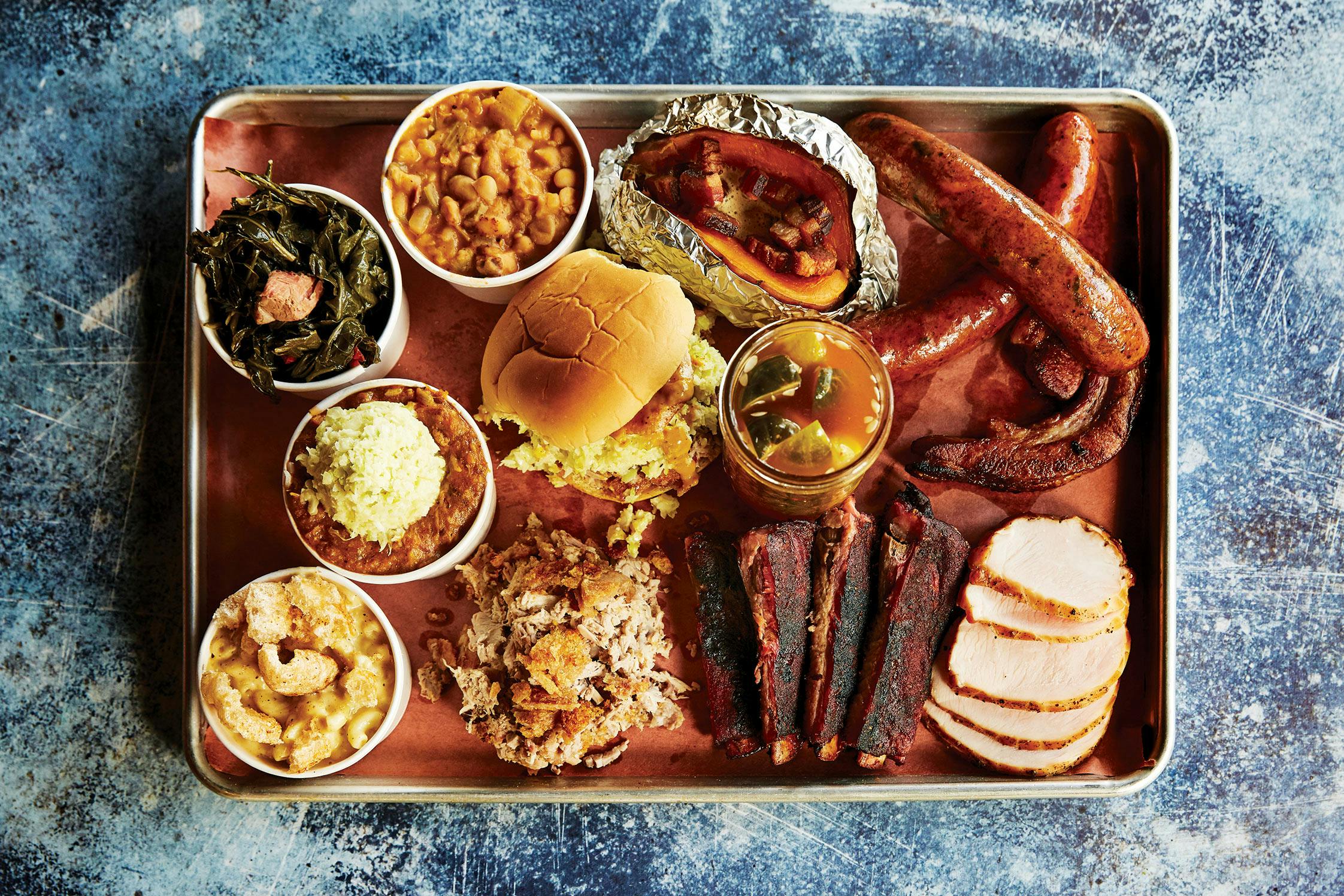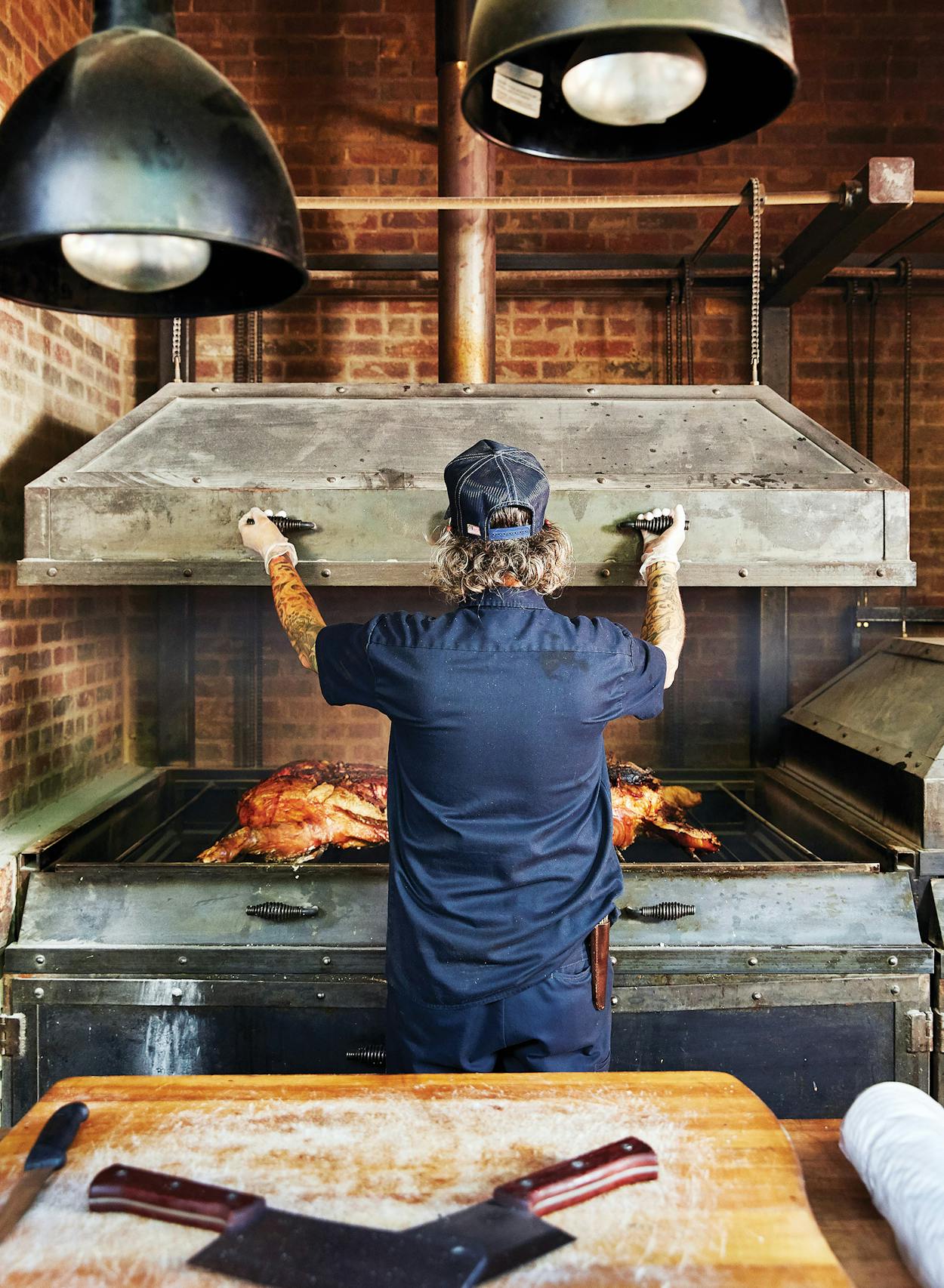Banger’s Sausage House in Austin might be the only barbecue joint in Texas that doesn’t have beef on the menu. Its announcement last year about opening its own smokehouse made big news in the barbecue community because the restaurant planned on serving whole-hog barbecue every day the smokehouse is open (Thursday–Sunday currently). Whole-hog cooking is a tradition associated with parts east of here, while Banger’s sits in the heart of smoked brisket country. That’s precisely why Ted Prater, head of culinary operations at Banger’s, said he and owner Ben Siegel decided to move away from the standard Texas barbecue offerings. Prater, a Tennessee native, asked himself, “When there’s so many people around me that are so much better at something that I do, then why bother trying to mimic or copycat what someone else has going on?”
Rather than providing another version of the smoked meats already so prevalent in Austin, the barbecue at Banger’s is more of a reflection of Prater. He’s been with the restaurant since it opened on Rainey Street in 2012. That was back before Rainey was overrun by scooters and bachelorette parties. Prater built pits out of concrete blocks for Banger’s Sunday barbecue parties, which began with whole hogs. “Then I started doing everything with a face,” Prater said, including alligators, ostrich, antelope, venison, and nutria. This informal operation continued for years, until it got so popular the city took a closer look. “The only reason we designed the smokehouse is because the city kept getting mad at me for starting fires everywhere,” Prater said.
Two years ago, he had just built a 65-foot-long grill to cook five different animals when the fire department showed up. According to Prater, Banger’s had to pay the fire department $122 per hour to monitor the cook for 24 hours. After that, they looked into a more permanent solution for outdoor cooking.


Prater has a strong Tennessee accent that would stand out among a crowd speaking in even the thickest Texas drawls. His beard alone could be cast as a moonshine runner in a Hollywood film. He wears overalls unironically and exhibits an easygoing, hospitable demeanor. He seems like a guy with a long history cooking whole hogs, because he is. “Barbecue is something I did in my backyard my whole life,” he told. Yet if you talk to him about his food for a while, you’ll realize his skills and thoughtfulness about cooking go well beyond the smokehouse.
Prater got his first restaurant job at age fourteen. He bused tables, washed dishes, and worked the grill at dive bars. “I did a stint at Pizza Hut at eighteen just because I was able to sell weed out of my Volkswagen Bug and deliver pizza at the same time,” he told me with a laugh. A job as the produce manager at the Corner Market—like a Whole Foods before Whole Foods reached Tennessee—in Nashville provided connections to farmers and fresh food. “I was driving out to all the farms and hand-picking the produce to come back and set up for display,” Prater said. He then took a chef position at a fancy restaurant in Knoxville and thought he was moving up in the world, until he realized it wasn’t the right fit for him. “I just woke up one day like, ‘This ain’t who I am. This ain’t what I do. My friends can’t eat here. My family don’t eat like this,'” he remembered thinking.
He set his sights on Texas and saw an ad for an upcoming sausage and beer house called Banger’s. Siegel didn’t respond to his application, but Prater kept sending messages. He finally got an interview in 2012, but he didn’t get a call back. Prater said he remembers calling Siegel to say, “Look, bro, you’re going to have to deal with me one way or the other. I’m either going to be your customer, or I’m going to work for you.” He got the job.

Now Prater is head of culinary operations, responsible for a whole lot more than sausage and barbecue. The restaurant’s recent expansion, which included the smokehouse, brought with it a fermentation program, cured meats, and lots of bacon. Prater explained that the varieties of bacon produced, at varying salt levels, each have different uses. There’s the bacon they panfry, of course. There’s also seasoning bacon that’s cubed and fills the center of a pit-cooked sweet potato, along with a generous scoop of sorghum butter. Then there’s the bacon that eats like a steak. That they first cure for three days in a bath of bourbon, coffee, and water with some sugar, black pepper, and salt. After the curing, it hangs for 24 hours before being pounded flat and then twisted up tight like a pancetta. It’s smoked for a few hours before it hangs over the direct heat of the smokehouse fire. Its skin gets crisped, and some of the fat drips out. To serve, a thick slice is cut and both sides are browned on a hot plancha. This bacon “steak” is tender, but still has a nice chew to it. It is cured and smoked pork belly, but the similarities between it and the bacon you might be expecting end there.
Turkey breasts are brined in sweet tea, salt, and pepper for at least eight hours. Afterward they’re coated with black pepper, folded, and netted to hang. They smoke for three hours in the net, and then are wrapped to finish cooking for another couple hours. A mahogany rind forms on the surface. It’s not tough, but it provides a smoky depth of flavor. The seasoning of the underlying meat prevents any of bites from tasting bland. It’s far more compelling than the smoked turkey breast at most joints.
Ham hocks are smoked and cured just to season the remarkable collard greens, which have a hint of sugar but a lingering savoriness. Prater cold-smokes cheddar and fontina cheeses for the mac and cheese. Crispy pork cracklins are served over the top to play against the creamy dish. You can taste the effort and attention to detail in these sides, which are anything but an afterthought.


It’s hard to categorize how they cook the whole hog, since it’s not beholden to any single barbecue style. It’s closer to the Eastern North Carolina approach than any other. Prater said he learned a lot from Samuel Jones of Skylight Inn and Sam Jones BBQ in North Carolina. The pit design, though, looks right out of South Carolina, “because I stole that straight-up from Rodney Scott,” Prater admitted, referring to the James Beard Award–winning Charleston pitmaster. Unlike its Carolina brethren, who cook commodity hogs, Banger’s uses only Compart Duroc pigs. Before cooking, the hog’s skin is salted to promote drying while it sits over the fire. The skin is then crisped over hot coals at the end of the cook and chopped together with the meat.
For the coals, they start with dense oak wood that’s still green, meaning it isn’t fully dry. Prater said it makes better coals to cook with, but it requires some time to create a good bed. “It takes me three hours to get my locomotive running, and then once I got that ember base, it’s kinda adding a log every hour for maintenance,” Prater said. The coals are shoveled directly under the meat, so it’s not cooked with indirect smoke like a typical Texas brisket. The smoke is also long gone before the coals are used, so you don’t get smoky wood flavor on the meat.
The hogs are cooked relatively quickly, just 10 hours from beginning to end, which is a lot faster than how Prater learned to cook in Tennessee. Back home he might spend a full 24 hours cooking a pig at a temperature as low as 180 degrees. This newer method works better for restaurant hours, but it doesn’t result in tough meat. There are some chunks in the mix. It’s chopped, rather than pulled. The sauce is mild but does provide a nice vinegar kick. Prater said he uses a mix of two sauces, one hot and the other with more vinegar, but he uses it sparingly. “Some guys try to cover something up,” he said about whole-hog cooks who heavily sauce. “I really think God mastered it right there when he made the pig. That’s the best animal on the face of the earth.”
Texans in love with beef barbecue may not agree with Prater’s assessment of pork supremacy, but I appreciate his honesty about why he’d rather not cook brisket. “I like cooking a pig, and I can guarantee that the pig is gonna be right,” he said. “I don’t have a real big passion behind cooking brisket,” so he doesn’t feel like he’d properly honor the brisket just by throwing it on the menu. He also has to sell that hog. “I got a pig to run through, so the more proteins I put up there, the more chance I take away from selling that pig,” he explained. For context, Banger’s needs to sell four hundred sandwiches to use an entire hog. Right now they only have that kind of demand on Saturdays and Sundays. Thursday and Friday crowds only need half a hog. They’re hoping the business grows to justify a whole hog every day that the smokehouse is open.

Running through that pig starts with the shoulder. A hog has lean and fatty cuts that must be mixed to create the right level of juiciness, but the shoulders alone have the proper balance. They are chopped first, and some of the crispy skin is mixed in. The process is done with batches as small as possible. If the chopped mixture sits too long, the crisp skin “sogs out really quick,” Prater said. Once the shoulders are chopped and served, they move to the loin, belly, and ham, and mix those together as the rest of the hog is served. It comes by the pound on butcher paper or on a sandwich with a sweet slaw that Prater accurately describes as “Kentucky Fried Chicken slaw.” A mustard sauce called Carolina Gold, which tastes as if it’s about 90 percent French’s yellow mustard, is liberally applied to the pork in the sandwich. It’s well made, but I preferred to enjoy a la carte portions of the pork and slaw in alternating bites.
When the hog has been picked through, and all the meat that’s fit for barbecue has been served, the remaining bones and scraps aren’t discarded. They’re boiled down into a rich stock that forms the foundation of their spicy barbecue hash. That’s a thick stew of pork, spices, and chicken livers to give it a little twang. The hash is served over fluffy white rice with a scoop of slaw on top. That final flourish isn’t something you’ll find in South Carolina, but I liked the mix of sweet slaw and spicy hash, and it turns that side cup into a full meal.
Of course, because this is Banger’s Sausage House, a couple links are on the smokehouse menu. There’s a straight pork sausage and a jalapeño cheese variety. They’re prepared differently than the sausage served on the main Banger’s menu—smoked pretty hot to come out with an incredible snap to the casing and a juicy texture. They’re pretty much perfect barbecue sausages. Although they don’t have any beef in them, they’ll be the most familiar Texas barbecue protein on the menu.
I’ve tried the barbecue at Banger’s on weekdays and weekends. Rainey Street is a nightmare of crowds on a Saturday if you’re just looking for a good plate of barbecue. It’s hard to dissociate Banger’s from the stereotypical Rainey scene of buzzed twenty-somethings bar-hopping on dangerously swerving scooters. If you can look beyond that, there’s real depth to the cooking at Banger’s. Each dish is thoughtfully prepared and well executed.
I asked Prater if the expense of the smokehouse was wise, given how successful Banger’s already was selling beer and sausage. To him it wasn’t a new concept, but simply an expansion of his weekend barbecue parties. He has always associated Banger’s with barbecue, and this new structure, the steel barbecue pits, and the barbecue menu just made that more official. He also enjoyed the idea of contributing something new to Texas barbecue: doing whole hog on a regular basis. They’re doing it well. “There’s only so much sausage that people want to eat,” he added, laughing. He and Siegel are hoping the same holds true for brisket.
Banger’s Sausage House
79 Rainey Street, Austin
(512) 386-1656
Hours for the Smokehouse: Thur-Sat 11-5, Sun 10-5 (or sold out)
Pitmasters: Ted Prater, Benjamin Armstrong, Alex Bender, and Ben Siegel
Method: Oak in a direct heat pit
Year Opened: 2012. Smokehouse opened in 2018

- More About:
- BBQ Joint Reviews
- Sausage
- Austin








